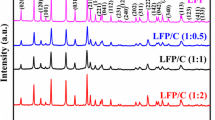Abstract
In this paper, powders of (Mg0.2Co0.2Ni0.2Zn0.2Cu0.2)O high-entropy ceramic oxides (HEOS) were prepared by a hydrothermal method. X-ray photoelectron spectroscopy (XPS), X-ray diffraction (XRD), scanning electron microscopy (SEM–EDS) and electrochemical technology were used to study the effect of different hydrothermal times on the performance of the HEOS. The obtained results showed that after prolonged hydrothermal treatment, crystalline high-entropy carbonates (Mg0.33Ni0.33Co0.33Zn0.33)CO3 (HECO3s) were formed, which facilitated crystal development and grain size reduction of their calcined product (Mg0.2Co0.2Ni0.2Zn0.2Cu0.2)O. The reduced grain size led to an increase in the specific surface area, which enhanced the electrochemical activity of Co and Ni in the high-entropy oxides and simultaneously considerably improved the electrochemical behavior of the product, resulting in an increase in the charge–discharge capacity from 465.8F/g to 921.1F/g at 0.1 A/g. The Jahn–Teller synergy of Co, Ni, and Cu ions stabilized the crystal structure during Li+ intercalation and deintercalation. Good charge/discharge reversibility and high capacity retention were maintained after 500 charge/discharge cycles.










Similar content being viewed by others
Data availability
The datasets generated and/or analyzed during the current study are available from the corresponding author on reasonable request. All data generated or analyzed during this study are included in this published article (and its supplementary information files).
References
D. Bérardan, S. Franger, D. Dragoe, A.K. Meena, N. Dragoe, Phys. Status. Solidi-R 10, 328 (2016)
B. Gludovatz, A. Hohenwarter, K.V.S. Thurston, H. Bei, Z. Wu, P.E. George, R.O. Ritchie, Nat. Commun. 7, 10602 (2016)
P. Sarker, T. Harrington, C. Toher, C. Oses, M. Samiee, J.P. Maria, D.W. Brenner, K.S. Vecchio, S. Curtarolo, Nat. Commun. 9, 4980 (2018)
Z. Gan, N. Song, H. Zhang, Z. Ma, Y. Wang, J. Electrochem. Soc. 167, 085501 (2020)
A. Huang, Y. Ma, J. Peng, L. Li, S.I. Chou, S. Ramakrishna, S. Peng, Science 1(2), 141–162 (2021)
E. Gabriel, D. Hou, E. Lee, H. Xiong, Energy Sci. Eng. 10(5), 1672–1705 (2022)
C.M. Rost, E. Sachet, T. Borman, A. Moballegh, E.C. Dickey, D. Hou, J.L. Jonesacob, S. Curtarolo, J.P. Maria, Nat. Commun. 6, 8485 (2015)
D. Bérardan, S. Franger, A.K. Meena, N.J. Dragoe, Mater. Chem. A. 4(24), 9536–9541 (2016)
S. Marik, D. Singh, B. Gonano, F. Veillon, D. Pelloquin, Y. Bréard, Scripta. Mater. 183, 107 (2020)
N. Qiu, H. Chen, Z. Yang, S. Sun, Y. Wang, Y. Cui, J. Alloy. Compd. 777, 767 (2019)
D.H. Lee, J.A. Lee, Y. Zhao, Z. Lu, J.Y. Suh, J.Y. Kim, J. Jang, I. Acta Mater. 140, 443 (2017)
T.X. Nguyen, J. Patra, J.K. Chang, J.M. Ting, J. Mater. Chem. A. 8(36), 18963–18973 (2020)
A. Poulia, E. Georgatis, A. Lekatou, A. Karantzalis, E. Int, J. Refract. Met. Hard. Mater. 57, 50–63 (2016)
E. Yao, N. Zhao, Z. Qin, H. Ma, H. Li, S. Xu, T. An, J. Yi, F. Zhao, Nanomaterials 10(4), 725 (2020)
M. Biesuz, L. Spiridigliozzi, G. Dell’Agli, M. Bortolotti, V.M. Sglavo, J. Mater. Sci. 53(11), 8074–8085 (2018)
Z. Rák, J.P. Maria, D.W. Brenner, Mater. Lett. 217, 300 (2018)
D. Berardan, A.K. Meena, S. Franger, C. Herrero, N. Dragoe, J. Alloys. Compd. 704, 693–700 (2017)
A. Sarkar, L. Velasco, D.I. Wang, Q. Wang, G. Talasila, L. Biasi, C. Kübel, T. Brezesinski, S.S.B. Hattacharya, H. Hahn, B. Breitung, Nat. Commun. 9, 3400 (2018)
Z. Rak, C.M. Rost, M. Lim, P. Sarker, C. Toher, S. Curtarolo, J.P. Maria, D.W.J. Brenner, Appl. Phys 120(9), 095105 (2016)
H. Seyama, M.J. Soma, Chem. Soc. Faraday. Trans. 80(1), 237–248 (1984)
V.I. Nefedov, Y.V. Salyn, G. Leonhardt, R.J. Scheibe, Electron. Spectrosc. Relat. Phenom. 10(1), 21–31 (1977)
M.H. Hsieh, M.H. Tsai, W.J. Shen, J.W. Yeh, Surf. Coat. Technol. 221, 118–123 (2013)
V.I. Nefedov, M.N. Firsov, I.S. Shaplygin, J. Electron. Spectrosc. Relat. Phenom. 26(1), 65–78 (1982)
K.S. Kim, N. Winograd, Surf. Sci. 43(2), 625–643 (1974)
C.V. Schenck, J.G. Dillard, J.W. Murray, J. Colloid Interface Sci. 95(2), 398–409 (1983)
A. Sarkar, R. Djenadic, D. Wang, C. Hein, R. Kautenburger, O. Clemens, H. Hahn, J. Eur. Ceram. Soc. 38(5), 2318–2327 (2018)
C.M. Rost, Z. Rak, D.W. Brenner, J.P. Maria, J. Am. Ceram. Soc 100(6), 2732–2738 (2017)
L. Yv, J. Wang, X. Li, L. Dai, Z. Shao, Ionics 27(9), 3769–3776 (2018)
Funding
China National Petroleum Corporation Petrochemical Research Institute Project (2021210207000265).
Author information
Authors and Affiliations
Contributions
Writing—original draft preparation: LY; Conceptualization and Writing—review and editing: JW; Funding acquisition: XW; Methodology: ZS; Formal analysis and investigation: JS, JT.
Corresponding authors
Ethics declarations
Conflict of interest
The authors have no relevant financial or nonfinancial interests to disclose.
Additional information
Publisher's Note
Springer Nature remains neutral with regard to jurisdictional claims in published maps and institutional affiliations.
Supplementary Information
Below is the link to the electronic supplementary material.
Rights and permissions
Springer Nature or its licensor (e.g. a society or other partner) holds exclusive rights to this article under a publishing agreement with the author(s) or other rightsholder(s); author self-archiving of the accepted manuscript version of this article is solely governed by the terms of such publishing agreement and applicable law.
About this article
Cite this article
Yv, L., Wang, J., Wang, X. et al. Effects of high-entropy carbonate precursors on the electrochemical properties of NaCl-based high-entropy ceramics as anode materials. J Mater Sci: Mater Electron 34, 1227 (2023). https://doi.org/10.1007/s10854-023-10602-8
Received:
Accepted:
Published:
DOI: https://doi.org/10.1007/s10854-023-10602-8




